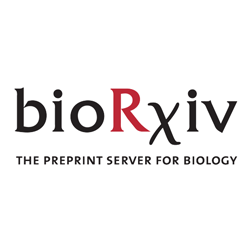
bioRxiv Neuroscience
@biorxiv_neursci
Followers
61K
Following
0
Media
0
Statuses
51K
Joined June 2016
Functional Connectivity Graph Theory Analysis of Spoken Word Processing Efficiency in Prefrontal Cortical Activation https://t.co/9dFlt5IlTK
#biorxiv_neursci
biorxiv.org
Purpose: The purpose of this study was to determine if functional near-infrared spectroscopy (fNIRS), and graph theory analysis of functional connectivity measures derived from hemodynamic changes in...
1
2
3
Therapeutic Potential of Flavonoids and Rutin Against Inflammation on a Huntington Animal Model https://t.co/4zjIbM15qk
#biorxiv_neursci
biorxiv.org
This study tested the hypothesis that flavonoids (diosmine, hesperidin and rutin®) play a protective role in the brain and duodenum against 3-NPA's free radical induced inflammation. This was...
0
0
0
Multiscale Spatial Transcriptomic Atlas of Human Basal Ganglia Cell-Type and Cellular Community Organization https://t.co/1tfBGfNbXf
#biorxiv_neursci
biorxiv.org
We generated a multi-region, subcellular-resolution spatial transcriptomic atlas of the human basal ganglia by integrating MERFISH+ and Stereo-seq across four neurotypical donors. These datasets...
0
1
0
Synthetic modulation of brain-wide anesthesia-activated neural ensembles using a transgenic mouse system https://t.co/CbJnhTRDdJ
#biorxiv_neursci
biorxiv.org
Anesthetics are commonly used to produce unconsciousness, but the neural substrates of unconsciousness remain poorly understood. Here we test the hypothesis that general anesthesia works by targeting...
0
0
6
Prodromal pathogenesis of CLN7 Batten Disease revealed by multimodal biomarkers in macaques https://t.co/ijkzwiFyJV
#biorxiv_neursci
biorxiv.org
Neuronal ceroid lipofuscinosis type 7 (CLN7) is a devastating paediatric neurodegenerative disorder with no cure and limited natural history data to guide therapeutic development. Here, we present...
0
0
0
Cognitive impairment and progressive neuroinflammation in mucopolysaccharidosis IIIA mice expressing the R245H Sgsh variant https://t.co/cQQKTL4fDQ
#biorxiv_neursci
biorxiv.org
Aims: Mucopolysaccharidosis (MPS) type IIIA (Sanfilippo syndrome) is an inherited childhood-onset dementia caused by insufficient SGSH enzymatic activity and subsequent accumulation of partially...
0
0
0
Lemborexant Reduces Infarct Volume and Improves Long-Term Functional Recovery in a Murine Model of Ischemic Stroke https://t.co/arRCOKuMcr
#biorxiv_neursci
biorxiv.org
Introduction: Recovery following ischemic stroke is highly variable and often incomplete, underscoring the urgent need to develop novel targeted poststroke treatments. While the mechanisms underlying...
0
0
3
Attention modulates hippocampal sharp-wave ripples in humans https://t.co/fMfzL6Y8Bd
#biorxiv_neursci
biorxiv.org
Hippocampal sharp-wave ripples (SWRs) are high-frequency events critical for memory consolidation, typically studied during sleep and quiet wakefulness. Emerging evidence suggests that SWRs also...
0
5
22
A dataset of differentiable biologically-derived single neuron models https://t.co/b7xUAvWq4Z
#biorxiv_neursci
biorxiv.org
Biological neural networks contain diverse cell types with heterogeneous electrophysiological properties. Artificial neural networks (ANNs) model computational aspects of biology but use homogeneous...
0
0
2
The language network responds robustly to sentences across diverse tasks https://t.co/3CLYWH66u0
#biorxiv_neursci
biorxiv.org
A network of left frontal and temporal brain areas supports language comprehension and production, implementing computations related to word retrieval and combinatorial linguistic processing. Here,...
0
1
1
Vagal volume receptors in the heart compensate for blood loss and posture change https://t.co/nAA6y5Wpbn
#biorxiv_neursci
biorxiv.org
Cranial nerves densely innervate the heart and vasculature, with sensory neurons reporting on blood pressure, respiratory gases, and tissue damage. The roles of arterial baroreceptors in systemic...
0
1
3
Cannabidiol Reduces D1 and D2 Medium Spiny Neuron Excitability in the Nucleus Accumbens Core https://t.co/5121yBLeo8
#biorxiv_neursci
biorxiv.org
Cannabidiol (CBD) is a non-psychotomimetic phytocannabinoid constituent of the cannabis plant that shows promise for the treatment of a variety of neuropsychiatric disorders such as anxiety disorde...
0
0
1
FDTest: Fluctuation-Dissipation Theorem as a Test for Memory Effects in Brain Dynamics https://t.co/xl9DRYZG2g
#biorxiv_neursci
biorxiv.org
A central challenge in neuroscience is to understand how the brain flexibly balances local and distributed information processing to support diverse cognitive and conscious states. We hypothesize...
0
0
1
Long-lasting structural and functional maturation in transplanted human neurons reprogrammed from glial progenitor cells https://t.co/MgYPVZRjMq
#biorxiv_neursci
biorxiv.org
Direct reprogramming of brain-resident glial progenitor cells (GPCs) into induced neurons (iN) shows great promise for future regenerative therapies for brain diseases. This type of cell conversion...
0
1
1
Novel Cln8 p.R24G mouse line replicates major clinical features of Northern epilepsy https://t.co/IcLRd26kQD
#biorxiv_neursci
biorxiv.org
Rationale. Northern epilepsy belongs to a group of genetically diverse lysosomal storage diseases, the neuronal ceroid lipofuscinoses (NCLs). A characteristic feature of NCL pathology is the accumu...
0
1
1
Locus coeruleus degeneration is associated with cortical tau deposition and cognitive decline in older adults at familial risk of ... https://t.co/sy3DQ7xb9n
#biorxiv_neursci
biorxiv.org
INTRODUCTION The locus coeruleus (LC) is among the first sites of tau pathology in Alzheimer's disease (AD) and may seed neocortical tau. METHODS We used longitudinal neuromelanin-sensitive MRI to...
0
0
2
Distinct Cortical and Oculomotor Dynamics During Endogenous and Exogenous Competition in Working Memory https://t.co/KwIQQazpB5
#biorxiv_neursci
biorxiv.org
Working memory (WM) enables the temporary maintenance of information for guiding thought and action, but its limited capacity requires internal selective attention mechanisms to prioritize goal-rel...
0
0
0
The 5-HT1A receptor selective agonist NLX-204 displays analgesic activity in the knee osteoarthritis and plantar incisional ... https://t.co/IgjYb9szXz
#biorxiv_neursci
biorxiv.org
Background: NLX-204 is a highly selective, high efficacy biased agonist at serotonin 5-HT1A receptors, which are well-established modulators of pain processing. Objective: To evaluate the analgesic...
0
1
4
Glucose and Oxygen Metabolism Coordinate Human Cortical Developmental Decisions https://t.co/zstRioBjZy
#biorxiv_neursci
biorxiv.org
Defining metabolic regulation of neurodevelopmental programs is essential to approach developmental disorders and injuries driven by alterations in metabolism. In vitro cultures are the only availa...
0
0
2
Assessment of Motoneuronal Regeneration and Wallerian Degeneration Following Axotomy in Postnatal Mice https://t.co/zxGFoxURnJ
#biorxiv_neursci
0
0
0
The Next Human Frontier: Space, AI, and the World We Dare to Create is a sweeping chronicle of the decisive moment when humanity stops reaching for space and begins living in it. Written in real time as the revolution unfolds, the book traces the intertwined rise of commercial
amazon.com
The Next Human Frontier: Space, AI, and the World We Dare to Create is a sweeping chronicle of the decisive moment when humanity stops reaching for space and begins living in it. Written in real time...
0
1
3



